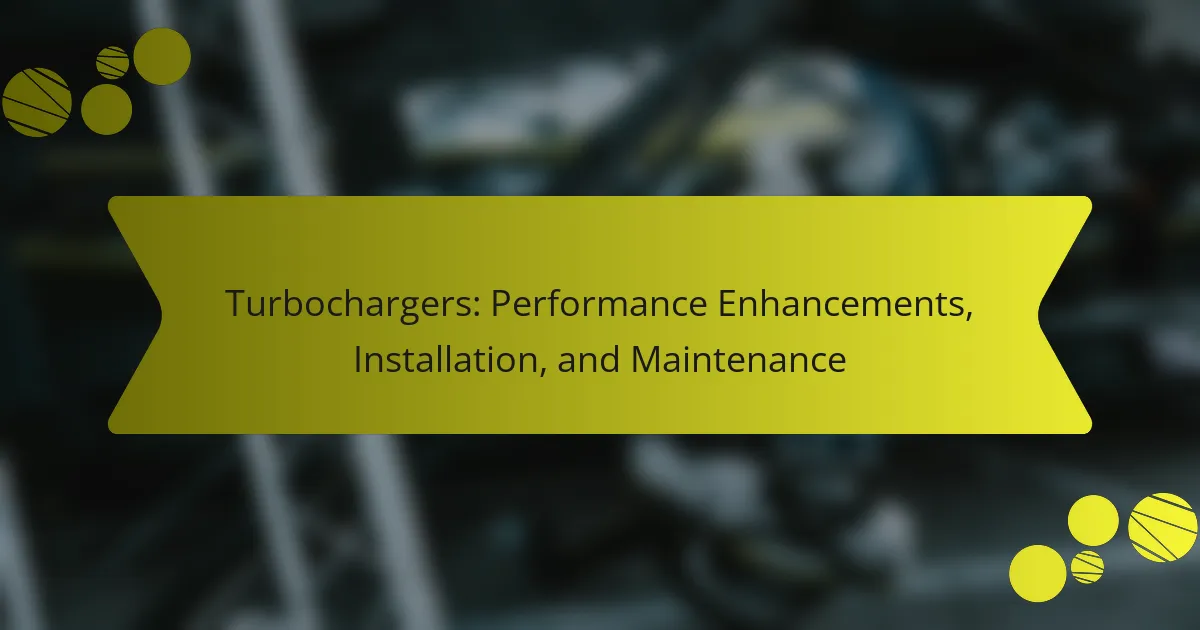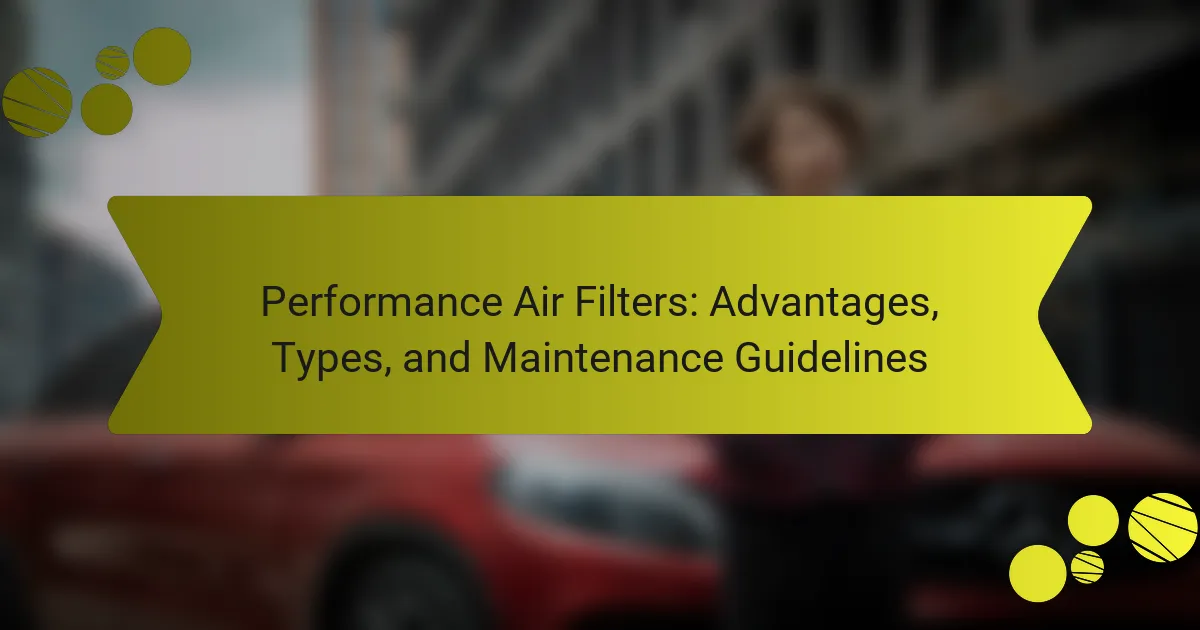Turbochargers significantly enhance engine performance by increasing efficiency and power output. This article explores their installation requirements, essential maintenance practices, and emerging technologies. Key features that maximize performance are also discussed, providing insights for optimal turbocharger use.
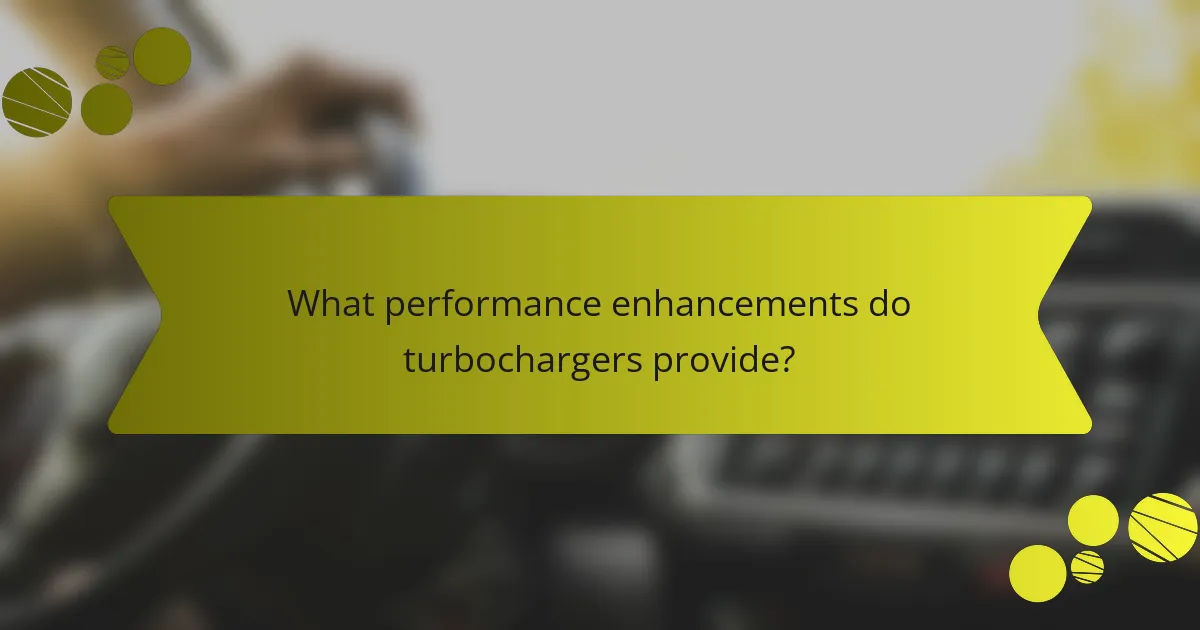
What performance enhancements do turbochargers provide?
Turbochargers enhance performance by increasing engine efficiency and power output. They compress air entering the engine, allowing for more fuel combustion. This results in higher horsepower and torque, improving acceleration and overall vehicle performance. Additionally, turbochargers can increase fuel efficiency by enabling smaller engines to produce more power compared to larger, naturally aspirated engines.
How do turbochargers improve engine efficiency?
Turbochargers enhance engine efficiency by increasing air intake, leading to better combustion. This process boosts power output without significantly increasing engine size. By forcing more air into the combustion chamber, turbochargers improve fuel efficiency and reduce emissions. This results in a higher power-to-weight ratio, making vehicles more responsive. Additionally, the use of turbochargers allows smaller engines to perform like larger ones, maximizing efficiency while minimizing fuel consumption.
What are the benefits of increased horsepower from turbochargers?
Increased horsepower from turbochargers enhances vehicle performance significantly. Turbochargers improve engine efficiency by forcing more air into the combustion chamber, resulting in higher power output without increasing engine size. This leads to quicker acceleration and better overall performance. Additionally, turbocharged engines often achieve better fuel efficiency, providing more power per gallon of fuel consumed. Enhanced horsepower also allows for improved towing capacity and better handling in various driving conditions.
Which factors influence turbocharger performance?
Turbocharger performance is influenced by several factors including engine size, boost pressure, and air-fuel mixture. Additionally, the design of the turbocharger, such as its turbine and compressor size, plays a crucial role. Proper installation and maintenance also significantly affect overall performance.

What installation considerations are essential for turbochargers?
Proper installation of turbochargers requires careful attention to several key considerations. Ensure the correct fitment to the engine’s specifications for optimal performance. Use high-quality gaskets and seals to prevent leaks. Adequate oil supply is crucial; check the oil lines for clogs and ensure proper routing. Monitor exhaust flow to avoid back pressure issues. Lastly, consider the intercooler setup to maximize air intake efficiency.
How do you choose the right turbocharger for your vehicle?
To choose the right turbocharger for your vehicle, assess your engine’s specifications, performance goals, and intended use. Start by identifying the engine’s displacement and power output to match a turbocharger that can optimize performance without causing damage. Consider the turbo’s size, which affects boost levels and response time. Evaluate your vehicle’s intended use, whether for daily driving, racing, or off-roading, as this influences the turbo’s design and features. Finally, research reputable brands and check compatibility with your vehicle’s make and model.
What are the steps involved in installing a turbocharger?
Installing a turbocharger involves several key steps to ensure optimal performance. First, gather necessary tools and parts. Next, remove the existing components, including the intake and exhaust systems. Then, install the turbocharger, ensuring proper alignment and sealing. After that, connect the oil and coolant lines. Finally, reassemble the intake and exhaust systems, and check for leaks before starting the engine.
Which tools and equipment are necessary for installation?
To install a turbocharger, essential tools and equipment include a socket set, torque wrench, screwdrivers, and pliers. Additional items like gaskets, oil, and coolant are also necessary for proper installation and maintenance.
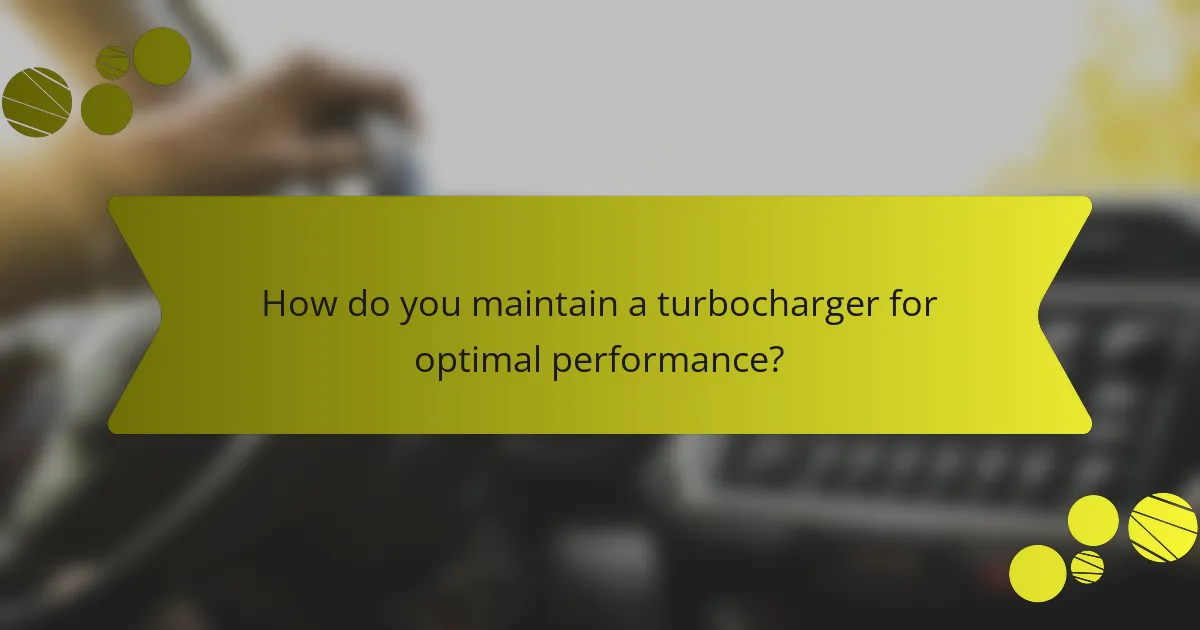
How do you maintain a turbocharger for optimal performance?
To maintain a turbocharger for optimal performance, regularly check oil levels, replace the oil filter, and inspect for leaks. Schedule routine cleaning of the intake and exhaust systems to prevent carbon buildup. Monitor boost pressure and ensure proper air-fuel mixture for efficiency. Using high-quality engine oil can enhance lubrication and reduce wear.
What routine maintenance tasks should be performed on turbochargers?
Routine maintenance tasks for turbochargers include regular inspections, oil changes, and cleaning of the intake and exhaust systems. Ensuring proper lubrication is crucial for longevity. Check for boost pressure leaks and monitor exhaust gas temperatures. Replace the air filter periodically to maintain optimal airflow.
How often should you inspect and service your turbocharger?
Inspect and service your turbocharger every 10,000 to 15,000 miles or annually, whichever comes first. Regular inspections ensure optimal performance and longevity. Check for signs of wear, oil leaks, and boost pressure issues. Addressing problems early can prevent costly repairs.
What are common issues that can arise with turbochargers?
Common issues with turbochargers include oil leaks, boost pressure loss, and excessive exhaust smoke. These problems can stem from wear and tear, improper installation, or lack of maintenance. Regular inspections and timely repairs can mitigate these issues, ensuring optimal performance. Additionally, a unique concern is turbo lag, which affects responsiveness during acceleration.

What unique turbocharger technologies are emerging in 2025?
Emerging turbocharger technologies in 2025 focus on electric-assisted designs and variable geometry systems. These innovations enhance efficiency and response time, significantly improving engine performance. Manufacturers are integrating advanced materials to reduce weight and enhance durability. Additionally, hybrid turbochargers are gaining traction, combining traditional and electric systems for optimal power delivery.
How do variable geometry turbochargers differ from traditional models?
Variable geometry turbochargers (VGTs) adjust their geometry to optimize performance across different engine speeds, unlike traditional turbochargers that operate at a fixed geometry. VGTs use movable vanes to control airflow, enhancing responsiveness and efficiency. This design allows for better low-end torque and reduced turbo lag. In contrast, traditional models may struggle with performance at lower RPMs. The adaptability of VGTs provides a unique advantage in modern engine applications, making them more suited for variable driving conditions.
What advancements in materials are enhancing turbocharger durability?
Advancements in materials such as advanced ceramics and high-strength alloys are significantly enhancing turbocharger durability. These materials withstand extreme temperatures and pressures, reducing wear and failure rates. For instance, ceramic matrix composites offer lightweight properties while maintaining structural integrity, contributing to improved performance and longevity. Additionally, surface coatings like thermal barrier coatings enhance resistance to thermal fatigue, further extending the lifespan of turbochargers.

Which rare turbocharger features can maximize performance?
Rare turbocharger features that can maximize performance include variable geometry, twin-scroll design, and integrated wastegate. Variable geometry allows for optimal boost across different RPM ranges, enhancing throttle response. Twin-scroll designs reduce turbo lag by separating exhaust pulses, improving efficiency. Integrated wastegates simplify installation and reduce potential points of failure, contributing to overall reliability.
What are the benefits of twin-scroll turbochargers?
Twin-scroll turbochargers enhance engine performance by reducing turbo lag and improving efficiency. They achieve this by separating exhaust pulses, allowing for quicker spool-up and more consistent power delivery. This design leads to better throttle response and increased horsepower. Additionally, twin-scroll turbochargers can improve fuel efficiency by optimizing exhaust flow, making them a valuable upgrade for performance-focused vehicles.
How can integrated electric turbochargers transform engine responsiveness?
Integrated electric turbochargers significantly enhance engine responsiveness by reducing turbo lag and providing immediate power delivery. These systems utilize electric motors to spool the turbocharger quickly, allowing for faster acceleration and improved performance. This technology enables engines to maintain optimal boost levels across a wider range of RPMs, enhancing efficiency and driving experience. Additionally, integrated electric turbochargers can optimize fuel consumption, making them a valuable upgrade for modern engines.
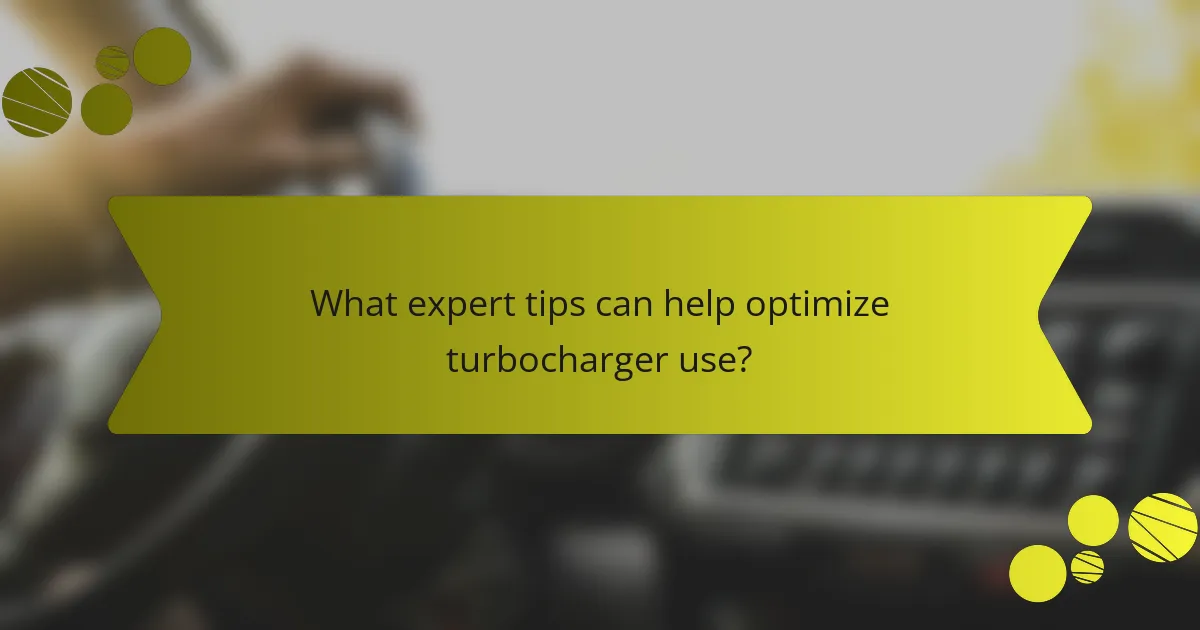
What expert tips can help optimize turbocharger use?
To optimize turbocharger use, focus on proper installation, regular maintenance, and tuning. Ensure the turbocharger is correctly sized for the engine to maximize efficiency. Regularly check for leaks and maintain oil quality to enhance performance. Adjusting the engine’s air-fuel mixture can also improve turbo responsiveness.
What common mistakes should be avoided during turbocharger installation and maintenance?
To avoid common mistakes during turbocharger installation and maintenance, ensure proper alignment and secure fittings. Neglecting to follow the manufacturer’s specifications can lead to performance issues. Additionally, failing to check for oil leaks or using incompatible oil can cause damage. Regularly inspect the air intake system for blockages or restrictions to maintain optimal performance.
How can tuning enhance the performance of a turbocharged engine?
Tuning enhances the performance of a turbocharged engine by optimizing air-fuel ratios and ignition timing. This process increases horsepower and torque, enabling better throttle response. A tuned engine can achieve maximum efficiency and power output, often resulting in a smoother driving experience. Additionally, tuning can address unique attributes like boost pressure management, which varies by engine type and desired performance levels.
